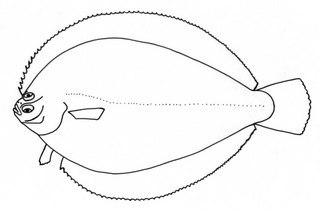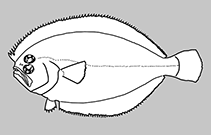
www.fao.org Copyright Michel Lamboeuf · 0
Etropus ciadi |
|
| Links |
We parsed the following live from the Web into this page. Such content is managed by its original site and not cached on Discover Life. Please send feedback and corrections directly to the source. See original regarding copyrights and terms of use.
- FishBase
|
|
espaŮol |
|
|
Overview |
Main identification features
- body deep ( greater than 1/2sl)
- pectoral - dark tip + bar
- lateral line has 36-43 scales
- dorsal fin 66-79 anal fin 52-62
Body relatively deep (47-60,mean 55% of SL); head small (22.1Ė26.6% SL); eyes close-set, lower one slightly before upper, a ridge between them that curves around and down behind lower eye to edge of preopercle; dorsal rays 66-79; anal rays 52-62; mouth relatively large for the genus, ends just behind front edge of lower eye, length <30% of head length; teeth small, in a single series, weak and mobile, concentrated on blind side of upper jaw; 2-7 upper gill rakers and 5-10 lower; 6 pelvic fin rays; tail fin with blunt angular point; lateral line straight, without arch above pectoral fin, not extending onto head; base of eye side pelvic on midline of body; urinary papilla on blind side, immediately behind anus; scales small, rough, easily dislodged, without small accessory scales; 36-43 lateral line scales.
Brown, with dark brown speckles on body and dorsal and anal fin rays, some grouped to form small spots; pectoral fin with dark tip and a wavy bar about 2/3 way along fin; males without dark pigment on blind side.
Reaches 11.6cm
Lives on soft bottoms
Depth range 8-40m
Known only from the eastern Gulf of California
Attributes
Cites: Not listed.
Climate Zone: North Temperate (Californian Province &/or Northern Gulf of California); Northern Subtropical (Cortez Province + Sinaloan Gap).
Depth Range Max: 40 m.
Depth Range Min: 8 m.
Diet: octopus/squid/cuttlefish; mobile benthic crustacea (shrimps/crabs); mobile benthic worms; bony fishes.
Eastern Pacific Range: Northern limit=32; Southern limit=25; Western limit=-115; Eastern limit=-109; Latitudinal range=7; Longitudinal range=6.
Egg Type: Pelagic; Pelagic larva.
Feeding Group: Carnivore.
FishBase Habitat: Demersal.
Global Endemism: East Pacific endemic; Tropical Eastern Pacific (TEP) endemic; All species.
Habitat: Sand & gravel; Mud; Soft bottom (mud, sand,gravel, beach, estuary & mangrove); Soft bottom only.
Inshore Offshore: Inshore; Inshore Only.
IUCN Red List: Not evaluated / Listed.
Length Max: 11.6 cm.
Regional Endemism: TEP endemic; Continental TEP endemic; Cortez province endemic; Continent only; Continent; All species.
Residency: Resident.
Salinity: Marine; Marine Only.
Water Column Position: Bottom; Bottom only;
|
|
|
Links to other sites | |
|
|
|
References |
- van der Heiden, A.M., Plascencia GonzŠlez, H.G., 2005., Etropus ciadi, a new endemic flatfish from the Gulf of California, Mexico (Pleuronectiformes: Paralichthyidae)., Copeia, 2005:470-478.
|
|
|
Acknowledgements | |
I thank Ashley MacDonald and John Pickering, University of Georgia, for technical support in building this page.
|
|
| Supported by | |
|
Following modified from FishBase
|
Top | See original
http://www.fishbase.org/Summary/speciesSummary.php?genusname=Etropus&speciesname=ciadi ---> http://192.134.151.83/Summary/speciesSummary.php?genusname=Etropus&speciesname=ciadi
http://192.134.151.83/Summary/speciesSummary.php?genusname=Etropus&speciesname=ciadi ---> https://fishbase.mnhn.fr/Summary/speciesSummary.php?genusname=Etropus&speciesname=ciadi
https://fishbase.mnhn.fr/Summary/speciesSummary.php?genusname=Etropus&speciesname=ciadi ---> https://fishbase.mnhn.fr/summary/Etropus-ciadi.html
Etropus ciadi

You can
sponsor
this page
Common name (e.g. trout)
Genus + Species (e.g. Gadus morhua)
-

-
About this page
-
Languages
-
User feedbacks
-
Citation
-
Uploads
-
Related species
-



Etropus
ciadi
van der Heiden
&
Plascencia Gonz√°lez
,
2005
Add your observation in
Fish Watcher
Upload your
photos
and
videos
Google image
 No image available for this species;
No image available for this species;
drawing shows typical species in Cyclopsettidae.
Classification / Names
Common names
|
Synonyms
| Catalog of Fishes(
genus
,
species
) |
ITIS
|
CoL
|
WoRMS
|
Cloffa
Teleostei (teleosts) >
Pleuronectiformes
(Flatfishes) >
Cyclopsettidae
(Sand whiffs)
Etymology:
Etropus:
Greek, etron, -on = lower abdomen + Greek, pous = feet
;
ciadi:
Named for Centro de Investigacíon en Alimentacíon y Desarrollo (CIAD).
.
Environment: milieu / climate zone / depth range / distribution range
Ecology
Marine; demersal; depth range 8 - 40 m (Ref.
57761
). Tropical
Eastern Pacific: Gulf of California.
Size / Weight / Age
Maturity: L
m
?
range ? - ? cm
Max length : 9.3 cm SL male/unsexed; (Ref.
57761
)
Found in soft bottoms at shallow depths (Ref.
57761
).
Life cycle and mating behavior
Maturity
|
Reproduction
|
Spawning
|
Eggs
|
Fecundity
|
Larvae
Distinct pairing (Ref.
205
).
van der Heiden, A.M. and H.G. Plascencia Gonz√°lez
, 2005.
Etropus ciadi
, a new endemic flatfish from the Gulf of California, Mexico (Pleuronectiformes: Paralichthyidae). Copeia 2005(3):470-478. (Ref.
57761
)
IUCN Red List Status (Ref.
130435
)
Least Concern (LC)
; Date assessed:
24 May 2007
CITES
Not Evaluated
Not Evaluated
Threat to humans
Harmless
Human uses
FAO - Publication:
search
|
FishSource
|
More information
Countries
FAO areas
Ecosystems
Occurrences
Introductions
Stocks
Ecology
Diet
Food items
Food consumption
Ration
Common names
Synonyms
Metabolism
Predators
Ecotoxicology
Reproduction
Maturity
Spawning
Spawning aggregation
Fecundity
Eggs
Egg development
Age/Size
Growth
Length-weight
Length-length
Length-frequencies
Morphometrics
Morphology
Larvae
Larval dynamics
Recruitment
Abundance
BRUVS
References
Aquaculture
Aquaculture profile
Strains
Genetics
Electrophoreses
Heritability
Diseases
Processing
Nutrients
Mass conversion
Collaborators
Pictures
Stamps, Coins Misc.
Sounds
Ciguatera
Speed
Swim. type
Gill area
Otoliths
Brains
Vision
Tools
E-book
|
Field guide
|
Length-frequency wizard
|
Life-history tool
|
Point map
|
Classification Tree
|
Catch-MSY
|
Special reports
Check for Aquarium maintenance
|
Check for Species Fact Sheets
|
Check for Aquaculture Fact Sheets
Download XML
Summary page
|
Point data
|
Common names
|
Photos
Internet sources
AFORO (otoliths) |
Aquatic Commons
|
BHL
|
Cloffa
|
BOLDSystems
|
Websites from users
|
Check FishWatcher
|
CISTI
|
Catalog of Fishes
:
genus
,
species
|
DiscoverLife
|
ECOTOX
| FAO - Publication:
search
|
Faunafri
| Fishipedia |
Fishtrace
| GenBank:
genome
,
nucleotide
| GloBI |
Google Books
|
Google Scholar
|
Google
| IGFA World Record |
MitoFish
|
Otolith Atlas of Taiwan Fishes
|
PubMed
| Reef Life Survey | Socotra Atlas |
Tree of Life
| Wikipedia:
Go
,
Search
| World Records Freshwater Fishing |
Zoobank
|
Zoological Record
Estimates based on models
Phylogenetic diversity index (Ref.
82804
): PD
50
= 0.5020 [Uniqueness, from 0.5 = low to 2.0 = high].
Bayesian length-weight: a=0.00871 (0.00387 - 0.01962), b=3.03 (2.83 - 3.23), in cm total length, based on LWR estimates for this (Sub)family-body shape (Ref.
93245
).
Trophic level (Ref.
69278
): 3.4 ±0.2 se; based on size and trophs of closest relatives
Resilience (Ref.
120179
): High, minimum population doubling time less than 15 months (Preliminary K or Fecundity.).
Fishing Vulnerability (Ref.
59153
): Low vulnerability (10 of 100).
Back to Search
Random Species
Back to Top
Accessed through:
Not available
FishBase mirror site :
localhost
Page last modified by :
mrius-barile
- 20 July 2016
Fatal error
: Uncaught ArgumentCountError: Too few arguments to function checkEcotox(), 1 passed in /var/www/html/summary/speciessummary.php on line 2304 and exactly 3 expected in /var/www/html/includes/speciessummary.lib.php:2579 Stack trace: #0 /var/www/html/summary/speciessummary.php(2304): checkEcotox() #1 {main} thrown in
/var/www/html/includes/speciessummary.lib.php
on line
2579
|
Updated: 2024-05-23 04:22:25 gmt
|